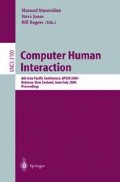Abstract
Preliminary themes to scaffold an investigative framework supporting human navigation from a egocentric (viewer-centered) perspective are de-scribed. These emerge from prototyping a mobile information appliance that supports, and is ecologically compatible with, human vision-based navigation and acquirement of spatial knowledge during movement through the physical world. The device assists a person finding his/her way from an origin to a destination by providing route information between images of landmarks, presented as they would be seen when walking rather than from an abstract map-type view. The use of the device in a foreign, built environment of the scale of a small university campus is illustrated and related to its use as a community authored resource. Emerging themes, such as the proximity, alignment and spatial separation of ”ready-to-hand” landmarks, are discussed. Suggestions for further exploration are proposed and related to intersubjective and cross-cultural differences in communicating and using information for piloting navigation
Access this chapter
Tax calculation will be finalised at checkout
Purchases are for personal use only
Preview
Unable to display preview. Download preview PDF.
References
Golledge, R.G.: Precis of Wayfinding Behavior: Cognitive Mapping and Other Spatial Processes. PSYCOLOQUY 10(36) (1999)
Schacter, D.L., Nadel, L.: Varieties of Spatial Memory: A Problem for Cognitive Neuroscience, Perspectives on Cognitive Neuroscience, Oxford, New York. (1991)
Wickens, C.D.: Spatial Perception and Cognition and the Display of Spatial Information. In: Engineering Psychology and Human Performance, Harper Collins, NY (1992)
Lynch, K.: The Image of the City. MIT Press, Cambridge (1960)
Thorndyke, P.W.: Performance Models for Spatial and Locational Cognition, Rand, Washington DC (1980)
Siegal, A.W., White, S.H.: The Development of Spatial Representations of Large-Scale Environments. In: Adv. in Child Dev. and Behav., vol. 10, pp. 10–55. Academic Press, London (1975)
Maguire, E.A., Burgess, N., O’Keefe, J.: Human Spatial Navigation: Cognitive Maps, Sexual Dimorphism and Neural Substrates. Curr. Op. in Neurobiology 9, 171–177 (1999)
Taylor, H.A., Tversky, B.: Perspectives in Spatial Descriptions. J. of Memory and Language 20(5), 483–496 (1996)
Tolman, E.C.: Cognitive Maps in Rats and Man. Psychol. Rev. 55, 189–208 (1948)
Pezdek, K.: Memory for Items and Their Spatial Locations by Young and Elderly Adults. Develop Psych. 19(6), 895–900 (1983)
McNamara, T.P.: Memory View of Space. Psychology of Learning and Motivation 27, 147–186 (1991)
Suomela, R., Roimela, K., Lehikoinen, J.: The Evolution of Perspective in WalkMap. Personal and Ubiquitous Computing 7(5), 249–262 (2003)
Abowd, G.D., Atkeson, C.G., Hong, J., Long, S., Kooper, R., Pinkerton, M.: Cyberguide: A Mobile Context-Aware Tour Guide. Wireless Networks 3(5), 421–433 (1997)
Cheverst, K., Davies, N., Mitchell, K., Friday, A.: Experiences of Developing and Deploying a Context-Aware Tourist Guide: The GUIDE Project. In: MOBICOM, ACM, New York (2000)
Simcock, T., Hillenbrand, S.P., Thomas, B.H.: Developing a Location Based Tourist Guide Application. In: Conferences in Research & Practice in IT, vol. 21 (2003)
Ohmi, M.: How Egocentric and Exocentric Information are Used to Find a Way in Virtual Environments? In: IIXth Conf. of Artificial Reality and Tele-Existence, pp. 196–201 (1998)
Flintham, M., Anastasi, R., Benford, S., Hemmings, T., Crabtree, et al.: Where On-Line Meets On-The-Streets: Experiences with Mobile Mixed Reality Games. In: Annual ACM SIGCHI Conference on Computer Human Interaction, pp. 569–576 (2003)
Levinson, S.: Frames of Reference and Molyneux’s question: Cross-linguistic Evidence. In: Bloom, P., Peterson, M., Nadel, L., Garrett, M. (eds.) Language and space, pp. 109–169. MIT Press, Cambridge (1996)
Vinsen, N.G.: Design Guidelines for Landmarks to Support Navigation in Virtual Environments CHI Papers, May 15-20, pp. 278–285 (1999)
Van Someren, M.W., Barnard, Y.F., Sandberg, J.A.C.: The Think Aloud Method: A Practical Guide to Modelling Cognitive Processes (KBS). Academic Press, London (1994)
Czerwinski, M., Tan, D.S., Robertson, G.G.: Spatial Cognition: Women Take a Wider View. In: ACM SIGCHI Conf. on Human Factors in Computing Systems, pp. 195–202 (2002)
Spencer, C.P., Darvizeh, Z.: Young Children’s Place Descriptions, Maps and Route Finding: A Comparison of Nursery School Children in Iran and Britain. Int. Journal of Early Childhood 15, 26–31 (1983)
Kearins, J.M.: Visual Spatial Memory in Australian Aboriginal Children of Desert Regions. Cognitive Psychology 13, 434–460 (1981)
Author information
Authors and Affiliations
Editor information
Editors and Affiliations
Rights and permissions
Copyright information
© 2004 Springer-Verlag Berlin Heidelberg
About this paper
Cite this paper
Bidwell, N.J., Lueg, C.P. (2004). Creating a Framework for Situated Way-Finding Research. In: Masoodian, M., Jones, S., Rogers, B. (eds) Computer Human Interaction. APCHI 2004. Lecture Notes in Computer Science, vol 3101. Springer, Berlin, Heidelberg. https://doi.org/10.1007/978-3-540-27795-8_5
Download citation
DOI: https://doi.org/10.1007/978-3-540-27795-8_5
Publisher Name: Springer, Berlin, Heidelberg
Print ISBN: 978-3-540-22312-2
Online ISBN: 978-3-540-27795-8
eBook Packages: Springer Book Archive

